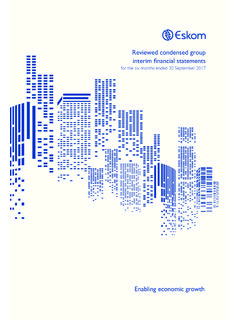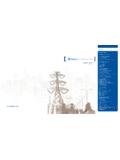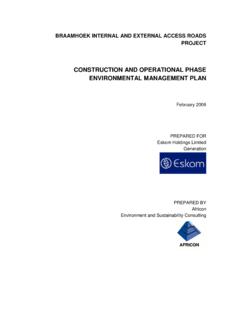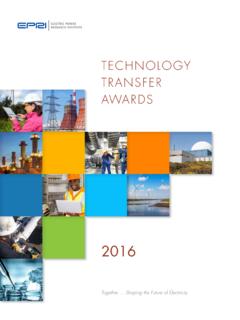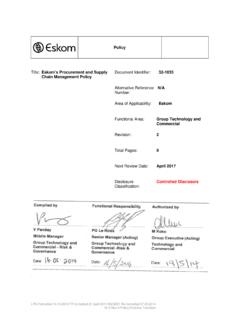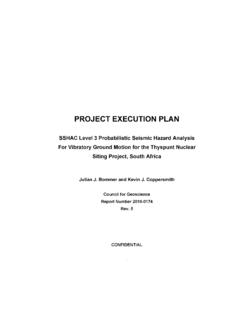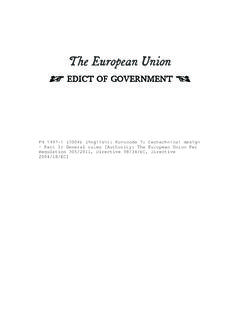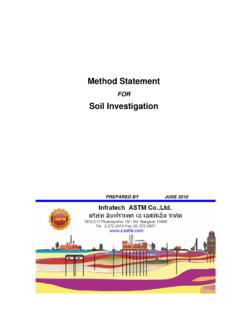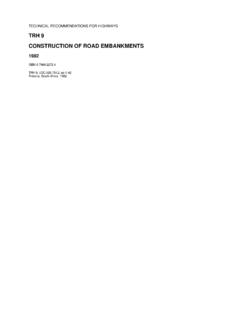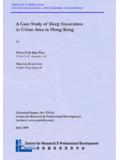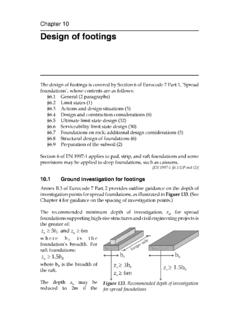Transcription of REPORT ON A GEOTECHNICAL INVESTIGATION FOR THE ... - …
1 Inroads Consulting Ref: 08102/g GEOTECHNICAL INVESTIGATION Eskom Landfill & Hazardous Waste Storage Facility- Lephalale April 2009 1 REPORT ON A GEOTECHNICAL INVESTIGATION FOR THE PROPOSED NEW ESKOM GENERAL LANDFILL AND HAZARDOUS WASTE FACILITY, LEPHALALE 1. TERMS OF REFERENCE This REPORT has been prepared at the request of Envirolution Consulting (Pty) Ltd and forms part of the specialist studies required for an Environmental Impact Assessment (EIA). It presents the results of a GEOTECHNICAL INVESTIGATION carried out within an area identified for the development of a general landfill and hazardous waste storage facility for Eskom near the town of Lephalale in the Limpopo Province. Since the INVESTIGATION forms a part of the specialist studies for the EIA for the facility, it has been undertaken in order to meet with the requirements of Chapter 6 of the document Minimum Requirements for Waste Disposal by Landfill(1).
2 This chapter deals with the Site INVESTIGATION , however, two sections of the chapter, namely Geohydrology and The Geohydrological REPORT , are not included in this REPORT as they form part of a Geohydrology study conducted by Blue Rock Consulting (Pty) Ltd, the results of which are contained in a separate REPORT prepared by them. 2. SCOPE OF WORK Based on the requirements of the aforementioned document, the investigative work has entailed establishing the physical geography of the area including the: Topography; Infrastructure; Climate and Vegetation. In addition to the above, the REPORT discusses the geological and GEOTECHNICAL conditions underlying the area and provides information on the: Geology; Soil conditions and; Miscellaneous issues. 3. INFORMATION SUPPLIED Information supplied during the course of carrying out the INVESTIGATION included: A REPORT titled Groundwater Pollution Risk Assessment and Compliance Monitoring at Matimba Power Station, prepared by Frank Hodgson and dated February 1995.
3 Inroads Consulting Ref: 08102/g GEOTECHNICAL INVESTIGATION Eskom Landfill & Hazardous Waste Storage Facility- Lephalale April 2009 2 A REPORT titled Groundwater Quality and Pollution Plume Modelling at Matimba Power Station by Riaan Grobbelaar, Lore-Mari Cruywagen, Elna de Necker and Frank Hodgson, dated October 2000. A REPORT dated 2006 and titled Interpretation of Groundwater Results Matimba Power Station Compiled by Danie Vermeulen of the Institute for Groundwater Studies at the University of the Free State. Various maps, plans and photographs of the area. 4. BACKGROUND TO THE DEVELOPMENT Whilst the Medupi Power Station is being constructed waste will be generated until it has been completed in about 2014. Approximately half of this will be hazardous waste and the other half general waste.
4 It is expected that existing Matimba Power Station will also generate the same amount of waste and in similar proportions. Also, the proposed two Waterberg Coal Fired Power Stations are likely to generate waste volumes slightly higher than that for the Medupi Power Station. All of these power plants have a design life of 50 years and the total waste generated from them over this period is expected to be of the order of 1 200 000 m3, split equally between general and hazardous waste. The approximate waste volumes generated from the power stations will require that Eskom provides a suitable waste management strategy and appropriate facilities. The latter will include access roads, weigh bridges, water pipelines for potable water, the waste disposal site, distribution lines for providing electricity to the facility and buildings such as offices.
5 5. THE SITE As alluded to above, the proposed landfill will be designed so as to accommodate both general and hazardous waste from the Medupi and Matimba Power Stations, as well as the proposed future Waterberg Power Stations and the nearby Eskom construction village in Maropong. The site selection process identified the following potentially suitable candidate sites: Four sites on the farm Grootvallei 515 LQ located adjacent to the Medupi Power Station, which is currently under construction. The farm Grootestryd located within the Matimba Power Station. Following a site selection process during the scoping exercise, the site located within the Matimba Power Station on the farm Grootestryd was considered the most favourable. Within this preferred area a further three sub-sites were identified as being suitable.
6 Inroads Consulting Ref: 08102/g GEOTECHNICAL INVESTIGATION Eskom Landfill & Hazardous Waste Storage Facility- Lephalale April 2009 3 6. INVESTIGATION The GEOTECHNICAL INVESTIGATION commenced with a desk study, which entailed obtaining as much information as possible of the site that may provide an indication of the most likely subsoil and associated GEOTECHNICAL conditions prevailing within the area. By determining the underlying geological setting together with the prevailing topographical and climatic conditions, the weathering characteristics of the host rock can be estimated and an indication of the most likely GEOTECHNICAL conditions underlying the site established. The information obtained from the desk study is discussed in Sections 7 and 8 of this REPORT .
7 The desk study was followed by a site reconnaissance which was carried out on Wednesday 17th December 2008 and entailed visiting the site and walking over the entire area whilst noting and recording information from visible surface features. Information from this phase of the INVESTIGATION , together with the desk study, provided a preliminary assessment of the GEOTECHNICAL conditions underlying the site and identified areas necessary for further INVESTIGATION . Following the desk study and reconnaissance survey described, the field INVESTIGATION was carried out on 18 to 20 March 2009 and entailed setting out and excavating twenty trial holes employing a CAT 416 Tractor-Loader-Backhoe (TLB) excavator. The holes, referenced TH1 to TH20, were excavated at the positions shown on the attached site plan, Figure 1, and were positioned so as to cover the footprint of the entire site.
8 The test pits were excavated to an average depth of 2,0 m ranging from 0,7 to 3,8 m below the present ground surface, and each of the holes was profiled in accordance with the standard methods prescribed in the document Guidelines for Soil and Rock Logging in South Africa (1990)(2) prepared by the GEOTECHNICAL Division of the South African Institute of Civil Engineers and the Association of Engineering Geologist of South Africa. The soil profiles are attached as Appendix A with this REPORT and the subsoil conditions discussed in Section 8. 7. GEOGRAPHY Based on the information acquired from the Desk Study phase of the INVESTIGATION , described in Section 5 of this REPORT , the information discussed below was obtained. Topography The site investigated covers an area of some 41 hectares, which includes the existing landfill facility, and is located in the western corner of the premises of the Matimba Power Station.
9 According to the 1:50 000 topographical map referenced DA Ellisras, the ground surface was originally fairly flat. However, it is presently undulating being covered with mounds of fill. A disused waste facility occupies the central south western sector of the site. It covers an area of some 11 hectares and comprises a perimeter earth wall within which ash, rubble and other waste has been discarded. Inroads Consulting Ref: 08102/g GEOTECHNICAL INVESTIGATION Eskom Landfill & Hazardous Waste Storage Facility- Lephalale April 2009 4 Figure Existing waste facility on the site Infrastructure Infrastructure in the area is limited to a buried high voltage cable which runs alongside about two thirds of the length of the boundary fence on the south western perimeter to the site.
10 A mini substation is located in the western corner. A disused water pipe installed by ISCOR runs alongside and over the full length of the north western boundary to the area, and a gravel surfaced road follows the electric fence which forms the south western and north western limits to the site. Climate Summer in the region extends from mid-October to mid-February and is characterised by hot, sunny weather often with afternoon thunderstorms. Winter occurs from May to July and is typified by dry, sunny, days and cold nights. The monthly distribution of average daily maximum temperatures range from 22,3 C in June to 31,9 C in January. The region is the coldest during July when temperatures drop to a minimum of 3,7 C at night. Lephalale receives some 400 mm of rain per year, with most of it occurring in mid summer.
